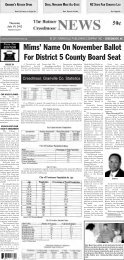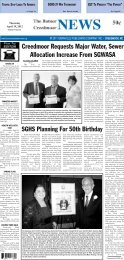Butnerthey
A Section 1,2, Jump - Butner Creedmoor News
A Section 1,2, Jump - Butner Creedmoor News
Create successful ePaper yourself
Turn your PDF publications into a flip-book with our unique Google optimized e-Paper software.
THURSDAY<br />
October 17, 2013<br />
THE BUTNER-CREEDMOOR NEWS<br />
COMMUNITY NEWS<br />
B SECTION<br />
B<br />
MAY HONORED<br />
Kathy Fuerst,<br />
principal at South<br />
Granville High School in<br />
Creedmoor has announced<br />
that Alan May<br />
has been named a<br />
Commended Student in<br />
the 2014 National Merit<br />
Scholarship Program. A<br />
Letter of Commendation<br />
Y OU<br />
D ECIDE :<br />
By Dr. Mike Walden<br />
N ORTH C AROLINA C OOPERATIVE E XTENSION<br />
from the school and<br />
National Merit Scholarship<br />
Corportation<br />
(NMSC), which conducts<br />
the program, will be presented<br />
by the principal to<br />
this scholastically<br />
talented senior.<br />
About 34,000<br />
Commended Students<br />
throughout the nation are<br />
HOW<br />
DOES<br />
GOVERNMENT<br />
SIZE IMPACT THE<br />
ECONOMY?<br />
Perhaps few topics can start a verbal clash more<br />
than the debate over government size and the<br />
economy. The competing sides are well known. One<br />
position says government gets in the way of the<br />
economy, by levying taxes, writing restrictive<br />
regulations and directing spending to less productive<br />
activities. The opposing side says government<br />
spending is vital to keeping the economy growing,<br />
improving lives and ensuring fairness.<br />
This debate is heard at both national and state<br />
levels. Ever since the federal government began<br />
running large annual budget deficits, the economic<br />
effects of government size have been a flashpoint. Also,<br />
here in North Carolina, the most recent session of the<br />
General Assembly featured a lively discussion about<br />
the role of government in economic growth.<br />
As I always strive to do, my role here is not to<br />
choose sides and promote a particular position but to<br />
present analysis and insights that economists have<br />
accumulated over decades of studying the intersection<br />
of government and the economy.<br />
First, let me begin by addressing how government’s<br />
size has changed in recent decades. Economists’<br />
preferred measure of the size of any sector in our<br />
economy -- whether it is government, manufacturing<br />
or health care -- is to look at spending in the sector as<br />
a percent of all income. This is similar to a household<br />
tracking its own spending by examining spending<br />
amounts for food, clothing, shelter or transportation<br />
as a percent of the household’s total income. The most<br />
comprehensive measure of aggregate income in our<br />
economy is a concept called "gross domestic income,"<br />
or GDP.<br />
At the national level, federal government spending<br />
as a percent of GDP has remained remarkably stable<br />
in recent decades, at around 19 percent. Of course,<br />
during recessions, when GDP declines and federal<br />
spending usually rises, the rate can move higher, often<br />
near 25 percent.<br />
There’s a similar picture in North Carolina. For<br />
the last 30 years, combined state and local government<br />
spending in our state -- omitting federal funds<br />
administered by the state -- has hovered around 6<br />
percent of North Carolina’s GDP. Again, the rate tends<br />
to move up during recessions and then back down<br />
during economic expansions.<br />
Next, can economists say anything definitive about<br />
the relationship between the relative size of<br />
government spending and the economy? There have<br />
been two levels of inquiry on this issue, one comparing<br />
countries from around the world and the other<br />
comparing states within the U.S.<br />
A recent economic paper summarized a large<br />
number of studies focusing on how the size of<br />
government affects the economic growth of nations.<br />
The authors concluded that the majority of studies<br />
showed a larger government sector leading to slower<br />
economic growth. However, the authors noted several<br />
caveats. First, the relationship was relatively small.<br />
Every one percentage point increase in government’s<br />
size as a percentage of GDP led to between a 0.05 to<br />
0.1 percent reduction in the annual national economic<br />
growth rate.<br />
Second, the relationship between government<br />
spending and economic growth depends on the type<br />
of spending. Many studies find that spending on<br />
education and infrastructure (highways) improves<br />
economic growth, while spending on transfer programs<br />
reduces growth.<br />
Third, some countries -- primarily in Scandinavia<br />
-- appear to be exceptions to the rule, with large<br />
government sectors but high economic growth. Some<br />
economists speculate these countries are able to<br />
counteract the adverse effects on growth of<br />
government size with pro-business regulatory and<br />
research policies.<br />
Now, what are the findings about government size<br />
and the economy at the state level? Unfortunately, the<br />
many studies done by economists linking the two are<br />
less than conclusive. Perhaps the best that can be said<br />
is that any effect that does exist is very small.<br />
There may be two reasons for this conclusion. First,<br />
the relative size of government at the state and local<br />
level is much smaller than the relative size of the<br />
federal government, so changes at the federal level<br />
will often have more impact. Also, most of the states<br />
are clustered within a couple of percentage points in<br />
measures for the relative size of their state and local<br />
governments.<br />
Second, there are a whole host of other factors that<br />
impact state economic growth besides the size of<br />
government, factors like the type and importance of<br />
different economic sectors in the state, the cost of doing<br />
business, worker training and skills, access to raw<br />
materials and markets, natural amenities and even<br />
the climate..<br />
People will continue to argue about the size of<br />
government, and economists will continue to churn<br />
out new studies looking at the impacts of government<br />
size and spending on the economy. Maybe the issue<br />
will never be resolved, but we’ll still try to decide!<br />
being recognized for their<br />
exceptional academic<br />
promise. Although they<br />
will not continue in the<br />
2014 competition for<br />
National Merit Scholarship<br />
awards, Commended<br />
Students placed<br />
among the top five<br />
percent of more than 1.5<br />
million students who<br />
entered the 2014<br />
competition by taking the<br />
2012 Preliminary SAT/<br />
National Merit Scholarship<br />
Qualifying Test<br />
(PSAT/NMSQT®).<br />
“The young men and<br />
women being named<br />
Commended Students<br />
have demonstrated<br />
outstanding potential for<br />
academic success,” commented<br />
a spokesperson<br />
for NMSC. “These<br />
students represent a<br />
valuable national resource;<br />
recognizing their<br />
accomplishments, as well<br />
as the key role their<br />
schools play in their<br />
academic development, is<br />
vital to the advancement<br />
of educational excellence<br />
in our nation. We hope<br />
that this recognition will<br />
help broaden their<br />
educational opportunities<br />
and encourage them as<br />
they continue their<br />
pursuit of academic<br />
success.”<br />
Tax & Business<br />
INFORMATION PROVIDED BY<br />
Cozart & Edwards, PA<br />
Certified Public Accountants<br />
REVIEW YOUR INVESTMENTS<br />
BEFORE YEAR-End<br />
This is a good time of year to review your<br />
investments. If you’re not meeting your financial<br />
goals for the year, there’s still time to make changes.<br />
Make sure your portfolio is appropriately balanced<br />
among stocks, bonds, and other investments. Keep it<br />
well diversified, without too much at risk in any one<br />
sector. And you’ll want to weed out investments with<br />
poor future prospects.<br />
As you identify investments to buy and sell, keep<br />
the following tax implications in mind:<br />
When you sell assets, you’ll have a capital gain<br />
or loss. Remember that capital gains on assets held<br />
for more than 12 months enjoy lower tax rates. For<br />
shorter holding periods, you’ll pay tax at ordinary<br />
income rates.<br />
Don’t forget to include any reinvested dividends<br />
when you calculate your cost basis for mutual fund<br />
shares.<br />
You can use capital losses to offset capital gains.<br />
Excess capital losses can even offset a limited amount<br />
of ordinary income.<br />
Watch out for the "wash sale rule." If you sell<br />
stock and then reacquire substantially identical<br />
securities within 30 days of a sale, you can’t deduct a<br />
loss from the sale.<br />
The law passed in January of this year sets the<br />
tax rate on long-term capital gains and qualified<br />
dividends at 20% for taxpayers in the 39.6% ordinary<br />
income bracket. Taxpayers in the two lowest ordinary<br />
income rates (10% and 15%) will have a 0% rate on<br />
capital gains and dividends. Those in all other<br />
brackets will continue to have a 15% rate on dividends<br />
and long-term capital gains.<br />
Changing investments within a tax-sheltered<br />
retirement account doesn’t have any immediate tax<br />
consequences. You’ll pay tax at ordinary income rates<br />
when you take distributions.<br />
Remember, taxes shouldn’t drive your investment<br />
decisions, but they are an important factor to consider.<br />
If you need assistance, give us a call.<br />
Senior Center<br />
Activities Schedule<br />
PO Box 766, Hwy 56E. & Main Street<br />
Creedmoor, NC 27522<br />
Week of Mon. Oct. 21, - Fri. Oct. 25, 2013<br />
Daily: 8:30 - 11:30 a.m. Walking in the Gym<br />
9:00 - 10:00 Coffee Hour<br />
12:00 - Lunch<br />
For More Information - Call 919 528-0848<br />
www.granvillecounty.org<br />
Click “Senior Services”<br />
Monday, Oct 21: 8:45 Game Time, 9:00 Trip: NC<br />
State Fair - Raleigh, 10:00 Acrylic Painting Class w/<br />
Alma Burke,11:00 Devotion: Minister Phil Morton,<br />
4:00 Zumba Gold.<br />
Lunch 12:00: Hamburger, Corn on the Cob,<br />
Lettuce/Tomato, Hamburger Bun, Milk.<br />
Tuesday, Oct. 22: 8:45 Game Time, 9:00 Low<br />
Impact Aerobics, 10:05 Exercise for Arthritis, 10:30<br />
Bible Study w/Dr. Mercedes Summers, 12:15 Water<br />
Aerobics - YMCA, No Computer Class Today, 1:00<br />
J.O.Y. Singers Practice.<br />
Lunch 12:00: Fried Fish, Stewed Tomatoes,<br />
Potato Salad, Cornbread Square, Milk.<br />
Wednesday, Oct. 23: 8:45 Game Time, 10:15<br />
Bingo (sponsored by Universal Healthcare, Oxford)<br />
Lunch 12:00: Brunswick Stew, Cornbread Square,<br />
Peaches, Milk.<br />
Thursday, Oct. 24: 8:45 Game Time, 9:00 Low<br />
Impact Aerobics, 10:00 Crochet Club, 10:05 Exercise<br />
for Arthritis, 12:15 Water Aerobics - YMCA, No<br />
Computer Class Today.<br />
Lunch 12:00: Roast Beef (for sandwich), Lettuce/<br />
Tomato, 4 Bean Salad, Wheat Bread, Milk.<br />
Friday, Oct 25: 8:45 Game Time, 9:00 Craft -<br />
Ceramic Classes w/Joan Harrison & John Smith, 10:30<br />
Fall Festival<br />
Lunch 12:00: Hot Dog, Bag Baked Chips, Hot<br />
Dog Bun, Coleslaw, Milk.<br />
• Milk is served with each meal - Chocolate milk<br />
and 2% low fat milk are available.<br />
Savvy<br />
Senior<br />
You ask the Senior question ~ We find the Savvy answer<br />
Help For Seniors Who Are<br />
Drowning In Clutter<br />
Dear Savvy Senior,<br />
My 67-year-old mother’s house has become a<br />
cluttered mess. Since my father died a few years ago,<br />
her house is so disorganized and messy with stuff that<br />
it’s becoming a hazard. I think she has a hoarding<br />
problem. What can I do?<br />
Worried Daughter<br />
Dear Worried,<br />
Compulsive cluttering is a problem that effects up<br />
to five percent of Americans – many of whom are<br />
seniors – with problems ranging anywhere from mild<br />
messiness to hoarding so severe it may be related to<br />
a mental health disorder like obsessive-compulsive<br />
disorder (OCD). Here’s what you should know, along<br />
with some tips and resources that can help your mom.<br />
Why People Hoard<br />
The reasons most people hoard are because they<br />
have an extreme sentimental attachment to their<br />
possessions, or they believe they might need their<br />
items at a later date. Hoarding also may be a sign<br />
that an older person is depressed, or showing early<br />
symptoms of dementia.<br />
Common problems for seniors who live in excessive<br />
clutter are tripping, falling and breaking a bone;<br />
overlooking bills and missing medications that are<br />
hidden in the clutter; and suffering from the<br />
environmental effects of mold, mildew and dust, and<br />
even living among insects and rodents.<br />
What To Do<br />
To get a handle on your mom’s problem, the<br />
Institute for Challenging Disorganization offers a free<br />
"Clutter Hoarding Scale" that you can download off<br />
their website at challengingdisorganization.org.<br />
If you find that your mom has only a mild<br />
cluttering problem, there are a number of things you<br />
can do to help.<br />
Start by having a talk with her, respectfully<br />
expressing your concern for her health and safety, and<br />
offering your assistance to help her declutter.<br />
If she takes you up on it, most professional<br />
organizers recommend decluttering in small steps.<br />
Take one room at a time or even a portion of a room at<br />
a time. This will help prevent your mom from getting<br />
overwhelmed.<br />
Before you start, designate three piles or boxes<br />
for your mom’s stuff – one pile is for items she wants<br />
to keep-and-put-away, another is the donate pile and<br />
the last is the throwaway pile.<br />
You and your mom will need to determine which<br />
pile her things belong in as you work. If your mom<br />
struggles with sentimental items that she doesn’t use,<br />
like her husband’s old tools or mother’s china for<br />
example, suggest she keep only one item for memory<br />
sake and donate the rest to family members who will<br />
use them.<br />
You will also need to help her set up a system for<br />
organizing the kept items and new possessions.<br />
Find Help<br />
If you need some help with the decluttering and<br />
organizing, consider hiring a professional organizer<br />
who can come to your mom’s home to help you<br />
prioritize, organize and remove the clutter. The<br />
nonprofit group National Association of Professional<br />
Organizers has a directory on the website at napo.net<br />
to help you locate an expert in your area.<br />
If she has a bigger, more serious hording problem<br />
(if her daily functioning is impaired, or if she is having<br />
financial difficulties, health problems, or other issues<br />
because of her hoarding) you’ll need to seek<br />
professional help. Antidepressants and/or talk therapy<br />
can help address control issues, anxiety, depression,<br />
and other feelings that may underline hoarding<br />
tendencies, and make it easier for her to confront her<br />
disorder.<br />
To learn more and find professional help see the<br />
OCD Foundation (ocfoundation.org/hoarding) which<br />
provides a hoarding center on their website that offers<br />
information, resources, treatments, self-help groups,<br />
and more.. Also see hoardingcleanup.com, a site that<br />
has a national database of qualified resources<br />
including cleaning companies and therapists that can<br />
help.<br />
Send your senior questions to: Savvy Senior, P.O.<br />
Box 5443, Norman, OK 73070<br />
FINANCIAL FOCUS<br />
CHRIS ELLIS<br />
EDWARD JONES INVESTMENT FIRM<br />
Lessons from “Save For Retirement Week”<br />
Congress has designated the third week of October<br />
as National Save for Retirement week - which means<br />
it’s a good time to think about your own retirement<br />
savings strategies.<br />
To help boost your prospects for a comfortable<br />
retirement, consider these suggestions::<br />
First, envision your retirement goals and estimate<br />
their costs. Knowing how much you’ll need to<br />
accumulate can help you develop appropriate<br />
investment strategies.<br />
And, of course, contribute as much as you can<br />
afford to your IRA and your 401(k) or other employersponsored<br />
retirement plan. Within these retirement<br />
accounts, consider putting appropriate amounts in<br />
growth-oriented vehicles.<br />
You’ll also need to review your progress toward<br />
your retirement goals. If your portfolio is<br />
underperforming, you may need to make some<br />
changes. And, in the years immediately preceding<br />
your retirement, you may want to shift some dollars<br />
into income-producing investments.<br />
National Save for Retirement Week comes just<br />
once a year. Take its message to heart.<br />
This article was written by Edward Jones for use<br />
by your local Edward Jones Financial Advisor.
















